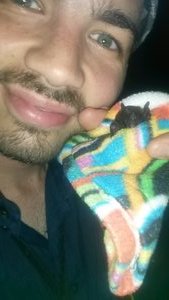Advertisement
Published: June 12th 2017

 20170609_210439
20170609_210439
holding my first wild bat Mist-netting Bats
My first night out in the jungle – and it was amazing. I accompanied other bat scientists to go mist-netting (
https://en.wikipedia.org/wiki/Mist_net). The goal was, to catch the common sword-nosed bat (Lonchorhina aurita), an exceptionally cute bat (see picture) from the family Phyllostomidae.
My first thoughts about the jungle at night were:
· there are many things that could sneak up on me without being seen
· there are snakes, right?
· there are jaguars in Panama
I soon realised, that every biologist would freely give their live for seeing a wild jaguar and would gladly record the whole “I´m being eaten alive” thing as footage for the rest of the world. If you have the feeling that I am exaggerating a bit, then you are probably right… my friends would probably take the part of recording ?. Anyways, it was remarkably beautiful to see fireflies in the dark and dense vegetation of the jungle, listening to a variation of frogs calling, and hearing howler monkeys for the first time. They really do sound weird. I would describe it as follows: imagine an enormous dog, puking violently while going through the puberty

 20170609_211333
20170609_211333
common sword-nosed batvocal change – sorry, I am exaggerating again ?.
Ok, let´s talk about our flying fur-balls: We set up our three mist-nets over a small stream and opened them after it got dark. It was my first time netting bats, so my friends showed me what to do. Afterwards, I freed my first bat myself. These animals are just wonderful. They seem to know that you want to help them get out again (not that it´s our fault they got in there in the first place…) and hold quite still – with the occasional attempt to sink they long and pointy teeth deep into your finger. But if you are careful, it doesn’t come so far. I used a towel to hold the bats and brought it in our camp, where we took measurements (armlength) and tried to determine the species. During the whole evening, we got Carollia perspicillata, Carollia castanea,
Artibeus jamaicensis, and of course Lonchorhina aurita. The feces-samples and ekto-parasites (bat-flies) from them are used for later scientific purposes. In total, we got around 15 bats. It was an exceptionally nice experience – I will do that as often as I can. On
our way home, everyone grabbed an ice-cold beer and was happy to finally take a shower ?
Advertisement
Tot: 0.167s; Tpl: 0.017s; cc: 9; qc: 52; dbt: 0.0984s; 1; m:domysql w:travelblog (10.17.0.13); sld: 1;
; mem: 1.1mb

 20170609_210439
20170609_210439
 20170609_211333
20170609_211333